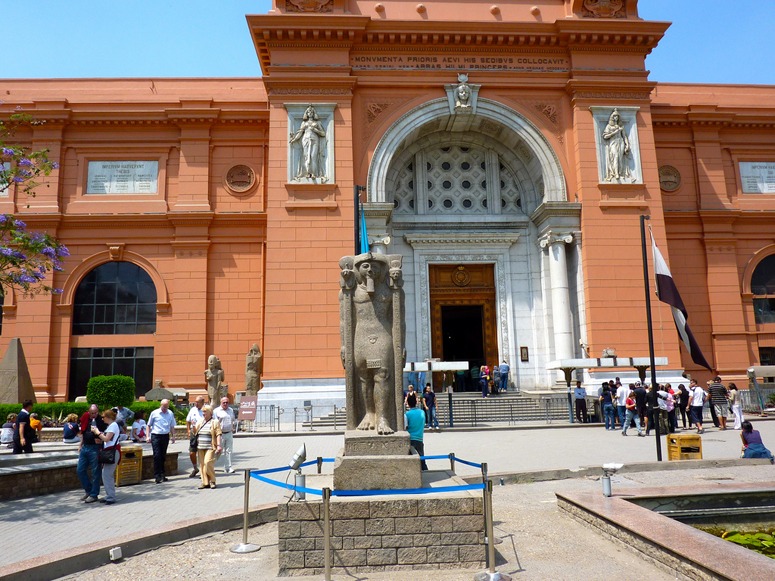
This is not a railway station: it is the Museum of Egyptian Antiquities – and a nearby building is on fire today. The thought of the antiquities being damaged is horrific and it makes me think they should be copied for public view and placed in secure underground bunkers. In fact they should make two copies. In the case of statues, one should go on display in a museum and the other should go in the place where it was found. This should be the normal procedure. For example, large numbers of statues were found at Hadrian’s Villa. Copies should be sited in their original locations.
I would love to see the Egyptians changing their government. But waiting till the old devil dies would be better than damaging the fabulous antiquities. Dr. Zahi Hawass, Secretary General of the Supreme Council of Antiquities (SCA), said two mummies were damaged by demonstrators. But his job came from Mubarak – so can he trusted?
It seems a petty point to add, but the Egyptian Museum also has material of the first importance to the study of garden history.
Image courtesy jkannenberg

It is to be hoped that Egypt will implement to the fullest extent the ‘Convention for the Protection of Cultural Property in the Event of Armed Conflict'(1954).
[ http://portal.unesco.org/culture/en/ev.php-URL_ID=35744&URL_DO=DO_TOPIC&URL_SECTION=201.html ]
If the government and persons charged with institutional responsibility are in some way hampered from doing this in situations of civil conflict perhaps a review of the mechanisms of the convention would be appropriate? Perhaps a UN cultural protection unit could be established to undertake the protection of world heritage in such an eventuality?
I saw some TV film of a tank outside the Museum of Antiquities and it gave me the shivers. None of my business, you might think, but I have been worrying for years about what would happen to the antiquities if there was a minor breach of the Asswan Dam. It would of course be a total disaster for Egypt but I think ‘our civilization’ has a separate responsibility for the works older civilizations. A new Grand Museum is being built and it has a secutiry strategy http://www.happoldsafesecure.com/PROJ_GrandEgyptianMuseum.aspx
Channel 4 News, a minute ago, reports ‘a seething mob, throwing petrol bombs, outside the Egyptian Museum’. Terrible.
It is very difficult when economics and politics trumps the protection of irreplaceable cultural heritage, as it did also with the building of the Asswan Dam. Elaboration of Article 4 (participation by persons) of the ‘Berlin Rules on Water Resources’ could potentially assist with this difficulty as well as the trans boundary issues of a shared water resource.
Perhaps a little breach in the dam wall might extinguish the petrol bombs? But who knows which would do more damage to the antiquities the water or the fire?
I think about the inhabitants of Old Gourna (Kurna/Qurna). It was a village of tomb robbers and, eventually, the state moved them away. But the state behaves in exactly the same way when it allows coach loads of sweaty tourists into the tombs: the moisture damages the paintings. Visitor management should be in the manner pioneered for the Altamira caves or the Chauvet caves. As previously discussed, I think access to Sissinghurst Castle Garden should also be limited, if not quite to the same extent.
The BBC World Service (Jim Muir, 5.15pm GMT) is describing the area near the Egyptian Museum as a ‘Battle Ground’ which is now ‘strewn with rubble and burnt-out vehicles’ and a ‘sea of devastation’. Muir adds that the government has stated its determination to protect the Museum ‘at all costs’. I doubt their determination and offer the following suggestions: (1) Central Cairo is full of tanks which could be used to block all roads leading to the museum. (2) They should pile sandbags on the land around the Museum (3) all tanks should be kept out of sight, so that then cannot become targets. (4) A regiment of unarmed soldiers should take up positions around the museum (5) another regiment, of armed soldiers, should be stationed behind the tanks which should be blocking the streets (6) fire engines should be stationed on the streetspace which is being used as as a ‘Battle Ground’. (7) There are now vast numbers of journalists in Cairo – and some of them, armed with cameras, should be allowed to stay on permanent watch outside the Museum.
See tragic photo of a damaged Mummy: http://www.guardian.co.uk/artanddesign/jonathanjonesblog/2011/feb/03/raiders-egyptian-museum-cairo-egypt
You might find Michael Kremer and Tom Wilkening’s paper ‘Protecting Antiquities: A role for long term leases?’ interesting. {I must admit I paid scant attention to the algorithms.) Although I think their suggestions leave open the problem of the contextual importance of artefacts insitu.
ps. Here is the paper link. [ http://www.law.columbia.edu/null/Kremer,+Michael+-+Fall+07+WS?exclusive=filemgr.download&file_id=13470&showthumb=0s ]
The leasing idea is interesting and should be tried – in a small experiment – to see if it works.
I am very sympathetic to the idea of making replicas.
Dr. Zahi Hawass has an interesting role in the developing situation in Egypt (1) he is now saying that none of the mummies were damaged (2) he is now a member of the cabinet which is discussing a transfer of power with the opposition parties.
I see Hawass as in a morally similar position to the tomb robbers: he sees the antiquities as a way of furthering his own career.